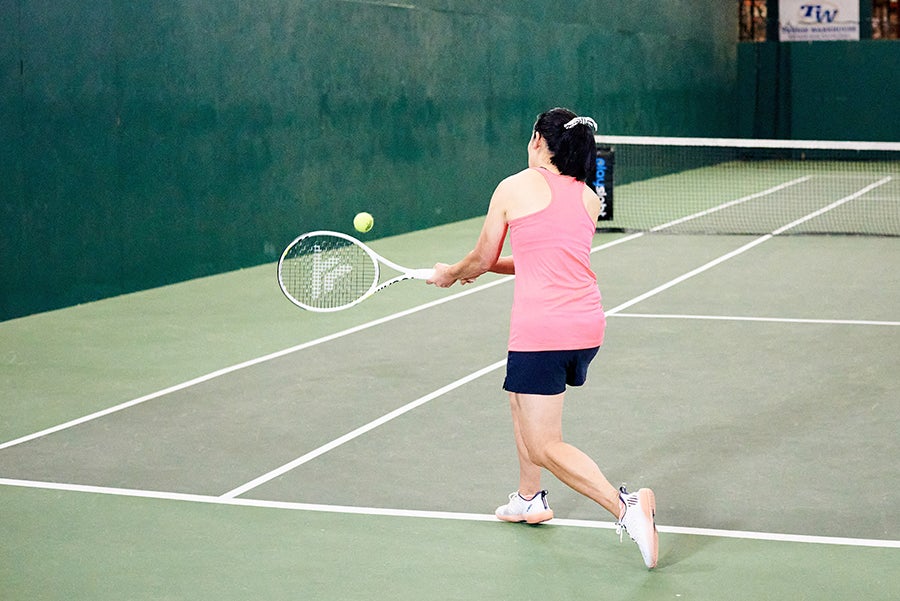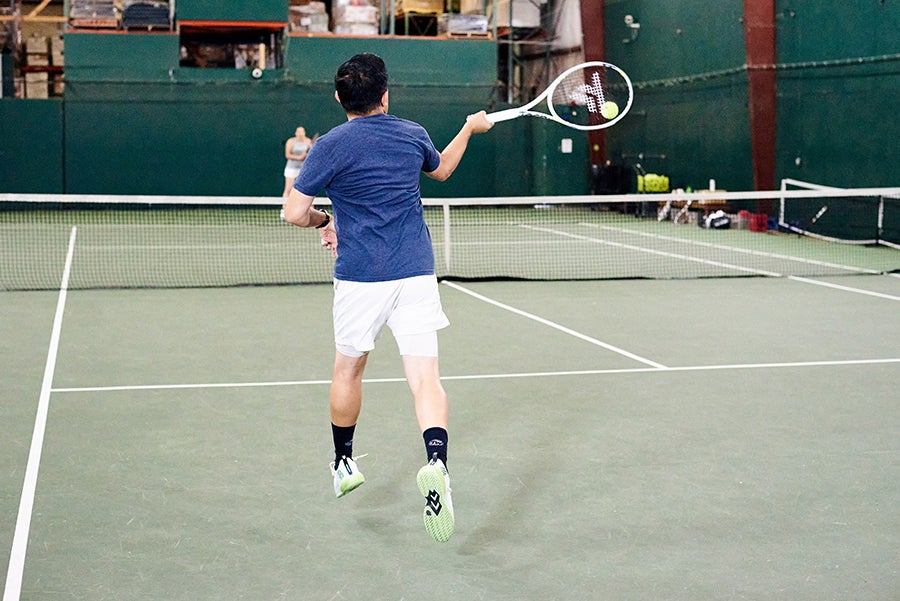Tecnifibre TF-X1 300 Racquet Review
| Overall | 82 |
|---|---|
| Groundstrokes | 82 |
| Volleys | 80 |
| Serves | 84 |
| Returns | 81 |
| Power | 88 |
| Control | 79 |
| Maneuverability | 86 |
| Stability | 77 |
| Comfort | 81 |
| Touch/Feel | 80 |
| Topspin | 86 |
| Slice | 83 |
Summary
New to Tecnifibre's racquet lineup, the TF-X1 300 brings a modern frame to market that combines comfort with an impressive blend of speed, spin and power. The TF-X1 300 features an updated vibration dampening system called X-Damp as well as Tecnifibre's IsoFlex System, which aids in creating a more consistent stringbed. The playtest was pretty straightforward for our playtest team, with the racquet proving to have a very user-friendly nature. Highlights were the racquet's speed through the air, the ease of creating spin and depth, and the effortless generation of power. As a light and powerful racquet, there were times when the power levels outshone the control factor, along with some moments of instability. Overall, the TF-X1 300 was fun to play with and offered a blend of characteristics that will cater to the improving player.
Upsides
- Power
- Spin
- Maneuverability
Downsides
- Stability
- Control on full swings
Ability
All
Groundstrokes - Score: 82
In the hands of our playtesters, the TF-X1 300 swung quickly through the air, which made it easy to whip up depth, spin and plenty of power. Chris tried the racquet with a few different string setups, finding he preferred the frame's performance best when strung with a co-poly. He explained, "I found super easy power and a very forgiving response when hitting groundstrokes with the TF-X1 300. I tried the racquet with both poly-based strings and multifilaments, and the multis were too powerful in this racquet. With a co-poly like Tecnifibre's Ice Code installed, I found much more control and lots of spin to help me get my shots to drop inside the lines. The more I hit with this racquet the more I loved the bite and spin I was getting on my backhand slice. I was very aggressive with my slice when setting up points or when trying to force an error. When pushed wide or deep, I could neutralize the rally and get back in the point with a more floated slice. My topspin shots were also working well. I liked the combination of pace and spin I was getting off both wings."
Brittany also noted the ease of resetting points, as well as the ability to use spin and angles to her advantage. She said, "When I first picked up the TF-X1 300 I noticed how maneuverable it felt. I was able to generate racquet head speed, which translated into easy power and depth on my groundstrokes. This was the case on both my offensive and defensive shots. I loved being on the full stretch and reaching for the ball and being able to deliver a deep shot back to stay in a neutral position. I was also able to whip my wrist around and create some great shorter, angled groundstrokes to pull my opponents off the court. Slices were solid; I hit them decently well and kept them low and penetrating."
Tiffani appreciated the easy maneuverability, but she noticed some moments of instability against bigger hitters. She commented, "I didn't look too closely at the specs before I started playing with the TF-X1 300. I found it to feel whippy and fast through the air, so I was quite surprised to find out the swingweight measured above 320. This racquet felt more tip-light than that, so I was finding it easy to access topspin, and I especially liked that fast feel on short balls. I was able to access lots of spin on my cross-court shots to pull my opponents wide off the court. I also found it easy to pick up balls hit deep at me when I was out of position. I could easily flick the racquet and get a decent shot off to keep me in the point. The drawback of that quick feel, however, was that it felt a bit unstable when I was facing harder hit shots. The racquet fluttered a little, but it did manage to stay comfortable."
Jason concurred with his fellow playtesters, adding that the power could get the best of him at times. He said, "This was an easy racquet to wield from the baseline. It offered really good access to power and spin in a maneuverable package. I found it easier to swing and generate racquet head speed than the listed swingweight led me to expect. When I was really trying to attack a ball, I did find that it could get slightly launchy, so I'd have to make sure I was really brushing up on the ball to get plenty of topspin. When swinging at anything under 90 percent power, I got easy depth on my shots."

Volleys - Score: 80
It was easy for our playtesters to get the TF-X1 300 into position when they moved forward into the net, but the stability wavered for some. For Tiffani, the racquet felt light and speedy enough to complement her net game. She said, "On volleys, I liked how quickly the racquet moved into position. That's my top priority at net because I'm not a super confident volleyer. It was easy enough to use, and it fit into my net style well. I like to keep it simple, and this TF-X1 had good power and enough stability to block volleys back deep and away."
Brittany saw her consistency waver a bit at net due to some instability issues. She explained, "Volleys had both positives and negatives for me. On the plus side, I found the TF-X1 to have a pretty comfortable and clean feel. I felt the sweetspot was more on the forgiving side as well. The racquet was easy to maneuver, so I was able to get it into position early. However, I was surprised that it was not as stable as I expected. I could feel it fluttering on some passing shots and some quick reflex exchanges. This led to me missing a couple more volleys, both when punching the ball deep or dropping it short."
Jason had a similar experience. He added, "I liked how quick this TF-X1 300 felt on reaction volleys, and I appreciated the pop I was able to put on sitter volleys, but I struggled when I hit a shot outside the sweetspot. All racquets lose performance and stability outside the sweetspot, but the lack of torsional stability was more evident with this TF-X1. I was expecting it to feel a bit more solid, à la the Pure Drive, but it fell short."
Chris found ways to adjust at net to keep his volleys on target. He said, "I found easy power that came with a crisp and clean feel on volleys with the TF-X1 300. The racquet felt fast in my hands. I felt confident both when closing the net and when looking to poach at net in doubles. To dial in my touch volleys, I found it best to cut under the ball and add spin. Fortunately, getting spin was easy thanks to the racquet's light and fast feel."

Serves - Score: 84
When the match gets tough, it's easy to get tight on serves. The TF-X1 300 made it easy for our playtesters to keep swinging freely and to start off points effectively. Jason enjoyed the attributes this frame brought to his service game. He explained, "The combination of easy spin and power made this a fun racquet to serve with. I was able to get some good pop on my serves while not losing control. On my second serve, the open string pattern helped me put lots of spin on my slices."
Serving proved effortless for Chris. He said, "I liked that I could generate enough pace and spin to serve effectively without having to put in much effort. I never once felt tired when playing with this racquet, even on long service games or when serving for extended periods during practice. My slice serve to the body worked well and helped me set up a lot of points."
The racquet also felt forgiving in Tiffani's hands. She commented, "I appreciated how easily this racquet swung over my head. I could serve without tiring, but it also meant that I could access spin a little easier than usual. I struggle to hit lots of spin on my serve, but I was having more success hitting slice serves than I normally do. I thought the power on my flat serve was decent with the TF-X1 300, but I recently tested the Tecnifibre TRebound 298 Iga, and I preferred that racquet for serves."
Brittany typically prefers returning to serving, but she found the opposite to be true with the TF-X1 300. She described, "I easily preferred to serve over return with this racquet. I was able to hit a variety of serves, from a flat, powerful first serve to a kick second serve. My arm never fatigued, and I was able to keep my swing speed up over the course of a hitting session. I appreciated really being able to snap my wrist on second serves to get some kick. Both first and second slice serves were effective as well, and I was able to hit them consistently, even under pressure."

Returns - Score: 81
While the TF-X1 300 could tap into plenty of power on returns, at times the power proved difficult to rein in. For Brittany, stability issues also came into play. She explained, "While I normally love to return serves, I wasn't quite gelling with the TF-X1 300 for a couple of reasons. The first was that it felt unstable (similar to volleys). I could definitely feel the racquet twisting in my hands on some hard-hit first serves. The second was that when I was returning second serves, the power level had me overhitting at times. I had to really dial back and be conscious of my swings."
Tiffani also experienced some instability here. She added, "I noticed the stability issues a bit more on returns than I did on groundstrokes. The TF-X1 300 twisted some in my hands when I was returning fast first serves or heavy spin serves. Like I mentioned earlier, the racquet still managed to feel comfortable enough despite the twisting. I did like to step in on second serves to attack. I thought it was easy to hit with power and depth on those slower serves, giving me a chance to be more offensive."
Chris noted the importance of utilizing spin to up his return percentage. He said, "I returned well with the TF-X1 300 as long as I made sure I generated spin with my stroke. The one downside was that it was easy to spray the ball long on flat shots. When hitting either topspin or slice, I found I could take healthy cuts at the ball and really get it moving."
Jason enjoyed tapping into the TF-X1 300's power and spin potential. He said, "Much like with my groundstrokes, the easy depth and power were the standout features. I enjoyed being aggressive on my returns with the TF-X1 300, not just with firepower alone, but also finding some sharp angles to pull my opponents off the court."
Overall - Score: 82
| Technical Specifications | ||
|---|---|---|
| Length | 27 in | 69 cm |
| Head Size | 100 in | 645.16 cm |
| Weight | 11.1 oz | 315 gm |
| Balance Point | 13 in 33.02 cm | 4pts HL |
| Construction | 24mm / 24mm / 24mm | |
| Composition | Graphite | |
| String Pattern | 16 Mains / 19 Crosses | |
| Babolat RDC Ratings | ||
|---|---|---|
| Score | Grade | |
| Flex Rating | 71 | Range: 0-100 |
| Swing Weight | 323 | Range: 200-400 |
| Chris' Scores | |||
|---|---|---|---|
| Power | 8.8 | Serves | 8.6 |
| Control | 7.8 | Groundstrokes | 8.3 |
| Maneuverability | 8.5 | Returns | 8.2 |
| Stability | 8 | Slice | 8.5 |
| Comfort | 8.2 | Topspin | 8.7 |
| Touch/Feel | 8 | Volleys | 8.2 |
| Overall | 8.3 | ||
| Tiffani's Scores | |||
|---|---|---|---|
| Power | 8.4 | Serves | 8.3 |
| Control | 7.8 | Groundstrokes | 8.2 |
| Maneuverability | 8.5 | Returns | 8 |
| Stability | 7.7 | Slice | 8.3 |
| Comfort | 8 | Topspin | 8.5 |
| Touch/Feel | 7.9 | Volleys | 8 |
| Overall | 7.9 | ||
| Jason's Scores | |||
|---|---|---|---|
| Power | 8.8 | Serves | 8.4 |
| Control | 8.2 | Groundstrokes | 8.4 |
| Maneuverability | 8.5 | Returns | 8.4 |
| Stability | 8 | Slice | 8.2 |
| Comfort | 8.2 | Topspin | 8.7 |
| Touch/Feel | 8.1 | Volleys | 8 |
| Overall | 8.3 | ||
| Brittany's Scores | |||
|---|---|---|---|
| Power | 9 | Serves | 8.4 |
| Control | 7.8 | Groundstrokes | 8 |
| Maneuverability | 9 | Returns | 7.8 |
| Stability | 7.2 | Slice | 8 |
| Comfort | 8.1 | Topspin | 8.3 |
| Touch/Feel | 8 | Volleys | 7.8 |
| Overall | 8.1 | ||
Playtester Profiles
Chris: 4.5 all-court player currently using the Tecnifibre TF40 305. Chris uses a full-western forehand grip, has a fast swing style and hits a one-handed backhand.
Tiffany: 4.0 level baseliner with a semi-western grip on the forehand and hits a two-handed backhand. Currently playing with the Prince Textreme Tour 100P (2015).
Jason: 4.0 baseliner with a semi-western forehand and two-handed backhand. Currently using a Prince Twistpower X100.
Brittany: Open level player with a semi-western forehand and a two-handed backhand. She currently plays with the Yonex EZONE 100 (300g).
Likes
Tiffani - "This TF-X1 300 feels quick through the air. It's easy to hit with power and depth."
Brittany - "I like the easy power, spin potential and maneuverability."
Chris - "Very forgiving, with easy power, spin and comfort. The TF-X1 300 also feels fast and maneuverable."
Jason - "Easy racquet to use. Great access to depth, power and spin, while also being easy to maneuver."
Dislikes
Tiffani - "This racquet feels unstable when the ball hits outside the sweetspot."
Brittany - "The TF-X1 300 feels unstable at times, especially on volleys and returns."
Chris - "The power level can get me into trouble on flat shots."
Jason - "Torsional stability up at net is not the best. It can get launchy and erratic on full swings."
Comparing the racquet to others they've tried, our testers said:
Tiffani - "This TF-X1 300 has a similar ease of use to a Babolat Pure Drive, but it does feel whippier through the air to me. Tecnifibre fans should also check out the TRebound 298 Iga racquet. The head size of the Iga racquet is slightly smaller at 98 square inches, but many of the specs are quite similar. I prefer the TRebound 298 Iga because it feels a little more solid, with slightly more control."
Brittany - "The Tecnifibre TF-X1 300 has the specs and characteristics of some of the most popular tweener racquets, including the Babolat Pure Drive, Yonex EZORE 100 and Dunlop FX 500. I would say it plays a little faster than all of them, but at the same time, it's a little less stable. The feel is also slightly more dampened to me."
Chris - "The TF-X1 300 offered bigger power and a more responsive stringbed compared to my old TFlash 300 PS. The response of this racquet sets it apart from previous Tecnifibre offerings. I like how the easy power and spin combine with ample comfort and a very forgiving response. Compared to other brands, I'd demo this one against the Head Graphene 360+ Extreme MP, Babolat Pure Drive and Yonex EZONE 100."
Jason - "If you like the Babolat Pure Drive or Wilson Ultra 100, this Tecnifibre TF-X1 300 fits right in with them."